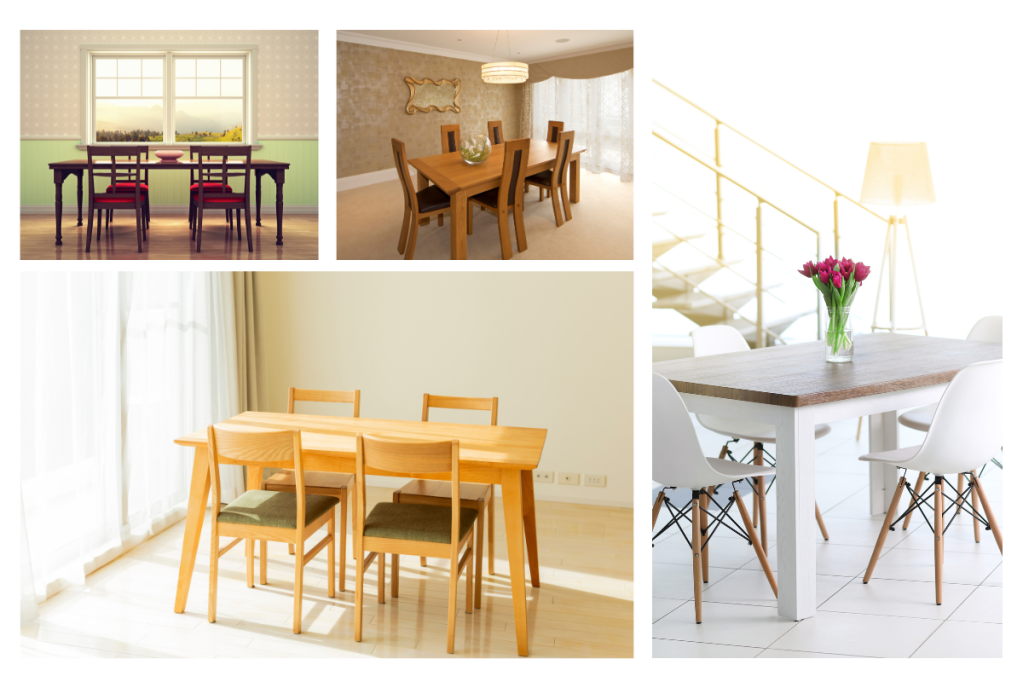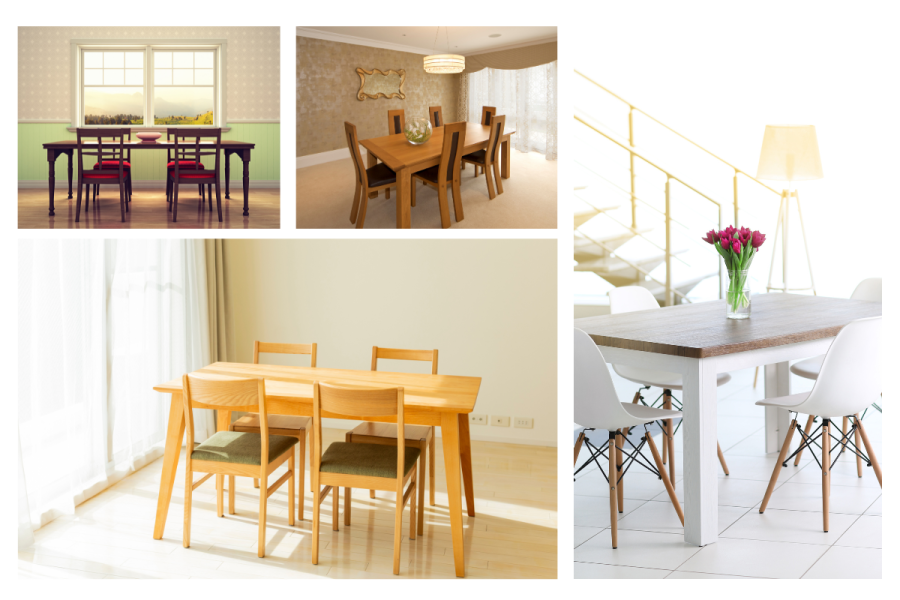Discover the art and science of dining table height. Learn about the ideal height for maximum comfort, leg room, and harmony with your dining chairs.

The Art of Ergonomics: How to Determine the Ideal Dining Table Height for Maximum Comfort
Dining tables come in different sizes. Ergonomic design involves finding the best height for comfort and function. Body posture, movement, and comfort are considered in ergonomics, which optimizes human performance and well-being. The appropriate dining table height can improve posture, prevent back pain, and improve the dining experience.
The “elbow rule” is a common method for measuring dining table height. This regulation recommends a tabletop height that puts diners’ elbows at 90 degrees. Measure the distance from the floor to the table’s underside and deduct 10-12 inches. This size accounts for the average height of dining chairs and leg room.
These rules are not universal. Height, body type, and desired seated posture determine the appropriate dining table height. A taller person may need a higher table height to sit comfortably. Table height can also be affected by chair type. A chair with a lower seat height may need a lower table, whereas a chair with a higher seat height may need a higher table.
In summary, height, body type, and desired seating posture determine the best dining table height for comfort. The “elbow rule” and other recommendations can be helpful, but table height should be customized to match individual needs. Ergonomic design can improve posture, prevent back strain, and enhance meals.
Beyond Eye-Level: Why You Should Consider Leg Room When Choosing Dining Table Height
Many people choose a dining table based on eye-level height, or the tabletop’s height relative to their seated eye level. Leg room is as crucial as eye-level height. Leg room is the distance between the seat to the table’s underside. Dining requires enough leg room for comfort and mobility.
Dining with little legroom might be uncomfortable. Taller people may have to bend their legs to fit under the table, which can strain them. This can cause back discomfort and other musculoskeletal disorders. Yet, too much leg room can create discomfort and instability.
Height and seated posture are crucial elements to consider while choosing leg room. The seat height of the chair utilized impacts leg room. A chair with a higher seat height needs more legroom than one with a lower seat height.
In conclusion, leg room and eye-level height should be considered while buying a dining table. Too much leg room can cause instability and pain, while too little might cause discomfort and strain. Height, preferred seated position, and chair seat height should be taken into account.
The Role of Chair Height: How to Ensure Your Dining Chairs and Table Work in Harmony
The height of your chairs affects how well your dining chairs and table work together. Your dining room’s feel and a chair’s comfort and support are affected by its height. Your dining chairs and table will work together to create a stylish, comfortable setting for you and your guests with the right chair height.
Consider the chair’s height and how it fits your dining table when choosing a dining chair. It’s uncomfortable to dine in chairs that are too tall or short for the table. The chair’s height and length should match the table’s. This will make the chairs and table match in height.
Additionally, the chair’s seat height will affect its comfort and support. High or low chairs can cause discomfort and posture issues. Thus, it’s crucial to choose chairs with seat heights that match the table and user.
In conclusion, chair height affects dining comfort and harmony. The chair’s height should match the table’s and be suitable for the user. These factors can help your dining chairs and table create a lovely and comfortable dining space.
The Impact of Material and Style on Dining Table Height: Choosing the Right Height for Your Table Type
Material and style should be considered when choosing a dining table height. The dining room table’s height and feel depend on its material and style. Understanding these factors can help you choose a table height.
Table height can vary depending on its material. For example, tables made from thicker materials like solid wood may need a higher height to be as stable as thinner tables made from glass or metal. Certain materials may also require a specific height to achieve the desired look and feel.
Table height can also be affected by style. For example, a pedestal-base table may need to be lower to make the tabletop comfortable for dining. However, a table with legs that reach the floor may need a higher height to ensure a comfortable dining height.
In conclusion, material and style affect dining table height, so consider them when choosing one. Tables made of thicker materials may need a higher height, while tables with a specific style may need a specific height to achieve the desired look and feel. These factors can help you choose the right table height for your table type and create a beautiful and comfortable dining space.
Elevating Your Dining Experience: The Benefits of Adjusting Dining Table Height for Different Occasions
Any experienced host knows that the perfect dining experience is more than just good food and good company. A good setting can make a meal memorable. Adjusting the height of your dining table can change the mood and formality for different occasions.
Formal dining can be enhanced by a higher table. Use a taller table or risers under the table legs to achieve this. A higher table height encourages guests to sit up straight, creating a more formal atmosphere. It can also create a sense of separation between the dining area and other parts of the home, making dining feel more special.
However, a lower dining table height can create a relaxed and comfortable atmosphere for more casual occasions. Using a lower table or removing risers from the table legs will accomplish this. A lower table height encourages guests to sit back and relax, making the dining experience more casual and intimate. This works well for family dinners and close friend gatherings.
Your dining table’s height can also be useful. For example, a lower table height may be more comfortable for working or playing games at your dining table. If you use your dining table for serving or displaying food, a higher table height may be better.
Conclusion
Choosing the right dining table height involves more than just eye-level height. Leg room is also a key factor to consider, as it affects comfort and ease of movement when dining. While there are guidelines such as the “elbow rule” to determine the ideal table height, customization based on individual factors such as height and preferred seating posture is important for maximum comfort and functionality. Ergonomic design principles can help prevent back pain, improve posture, and enhance overall dining experience. It is also important to choose chairs with appropriate seat heights to ensure that the table and chairs are well-matched.
The height of your dining table plays a critical role in creating a comfortable and stylish dining space. The height of your chairs, the material of the table, and the style of the table all play an important role in determining the ideal height for your table. By carefully considering these factors, you can choose the right height for your table type and create a beautiful and functional dining space. Additionally, it’s important to consider the needs of those who will be using the dining table. If you have tall or short individuals in your household, it may be necessary to adjust the height of the table to accommodate their needs. For example, a tall individual may require a higher table height to ensure that they can comfortably reach their food and drink.
Adjusting the height of your dining table can have a significant impact on the atmosphere and functionality of your dining space. By considering the occasion and your specific needs, you can choose the perfect dining table height to create a memorable and enjoyable dining experience for yourself and your guests. Whether you opt for a higher or lower table height, remember that the most important thing is to create a space that is comfortable, functional, and aesthetically pleasing.
